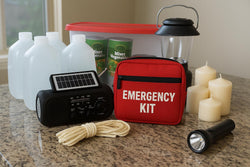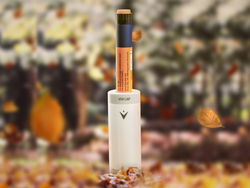Tempramed Blog
The Complete Guide to Insulin Storage: What Everyone With Diabetes Should Know in 2025

Proper insulin storage can mean the difference between stable blood sugar control and dangerous complications. With insulin spending having tripled over the past decade, and a single pen costing $50-$300, understanding how to store insulin correctly protects both your health and wallet.
Patients with diabetes account for 12% of emergency department visits and 26% of hospitalizations, with many of these visits potentially preventable through proper medication management, including correct insulin temperature control. Whether you're newly diagnosed or a diabetes veteran, this guide covers everything you need to know about insulin storage in 2025.
Why Insulin Storage Matters More Than You Think
Insulin is a protein hormone remarkably sensitive to environmental conditions. Unlike many medications stable at room temperature, insulin's molecular structure can be irreversibly damaged by temperature fluctuations, light exposure, and physical agitation.
The consequences of using degraded insulin include:
- Unpredictable blood sugar spikes that resist correction
- Diabetic ketoacidosis (DKA) in people with Type 1 diabetes
- Severe hypoglycemia from compensatory overdosing
- Long-term complications from poor glycemic control
- Financial losses from wasted medication
According to the American Diabetes Association, insulin should be stored in a refrigerator at approximately 36°F to 46°F (2-8°C), and insulin degradation accelerates rapidly above 86°F (30°C), with freezing permanently destroying insulin effectiveness even after thawing.
Temperature Requirements by Insulin Type
Rapid-Acting Insulins (Lispro, Aspart, Glulisine)
Unopened Storage: Refrigerate at 36-46°F (2-8°C) until expiration date. Never freeze—freezing permanently damages insulin structure.
In-Use Storage: Room temperature 68-77°F (20-25°C) for up to 28 days maximum. Discard after 28 days regardless of appearance.
Critical Temperature Limits:
- Below 32°F (0°C): Permanent damage occurs
- Above 86°F (30°C): Rapid degradation begins
- Above 100°F (38°C): Significant potency loss within hours
Long-Acting Insulins (Glargine, Detemir, Degludec)
Unopened: Refrigerate at 36-46°F (2-8°C) in original packaging to protect from light.
In-Use: Room temperature up to 42 days for most formulations:
- Glargine (Lantus): 28 days maximum
- Degludec (Tresiba): 56 days maximum
- Temperature range: 68-77°F (20-25°C)
Intermediate and Premixed Insulins
NPH and combination insulins follow identical refrigeration requirements but have unique mixing needs. Room temperature storage: 28 days maximum. Require gentle mixing—never shake vigorously as this damages protein structure.
Critical Storage Mistakes That Damage Insulin
Mistake #1: Hot Car Storage
Car interiors reach 140°F (60°C) in summer heat. At these temperatures, insulin degrades within 30 minutes. Emergency physicians report patients with unexplained blood sugar spikes who discovered they left insulin in hot cars.
Solution: Always carry insulin with you. For reliable protection, use temperature-controlled storage like the VIVI Cap from TempraMed, which maintains safe temperatures even in extreme heat conditions.
Mistake #2: Freezing Insulin
Frozen insulin becomes permanently inactive. Ice crystals irreversibly damage protein structure, even after thawing.
Common scenarios:
- Storing too close to freezer compartments
- Leaving in unheated cars during winter
- Packing in checked luggage during air travel
The TempraMed VIVI Cap prevents both freezing and overheating, providing consistent protection in all weather conditions.
Mistake #3: Light Exposure
Ultraviolet light breaks down insulin proteins. Sunlight and fluorescent lighting are particularly damaging.
Hidden exposure sources:
- Dashboard storage while driving
- Clear medication organizers in bright rooms
- Bathroom medicine cabinets with bright lighting
Solution: Keep insulin in original packaging or use opaque temperature-controlled storage solutions like TempraMed's VIVI Cap, which provides both temperature and light protection.
Mistake #4: Using Expired Insulin
Even properly stored insulin loses potency over time. Follow specific timelines:
- Unopened insulin: Use by manufacturer expiration date
- Opened insulin: 28-56 days depending on type
- When uncertain: Replace the insulin
Recognizing Insulin Degradation
Important: Visual Signs Are Unreliable
- Modern insulin typically shows NO visible changes when losing potency
- Clear insulin can be completely ineffective while appearing normal
- Never rely on appearance alone to determine insulin quality
Visual Warning Signs
Some insulin types might show:
- Cloudiness or discoloration
- Floating particles or clumps
- Crystalline formations
- Any color change from crystal clear
Cloudy Insulins (NPH, Premixed):
- Clumping that won't mix with gentle agitation
- Crystalline deposits on container walls
- Persistent separation after mixing
- Unusual color changes
Performance Indicators
Blood sugar patterns suggesting degraded insulin:
- Unexplained high readings despite proper dosing
- Sudden insulin resistance development
- Need for significantly higher doses
- Unpredictable glucose responses
Physical symptoms:
- Increased thirst and urination
- Fatigue and weakness
- Blurred vision
- Ketones in urine (Type 1 diabetes)
Travel Storage Solutions
Traveling with diabetes presents unique insulin storage challenges, but proper planning ensures medication effectiveness throughout your journey.
Air Travel Guidelines
TSA Regulations 2025:
- Insulin exempt from liquid restrictions
- Carry in original packaging with prescription labels
- Bring extra supplies for delays
- Never pack in checked luggage due to temperature extremes
In-flight storage:
- Keep in personal item bag
- Avoid overhead bins with temperature fluctuations
- Use insulated cases for additional protection
The TempraMed VIVI Cap is TSA-approved and provides reliable insulin protection during air travel without requiring power or batteries.
Ground Transportation
Essential practices:
- Never leave insulin in parked vehicles
- Use climate control to maintain cabin temperature
- Consider portable cooling for extended trips
- Plan stops for blood sugar monitoring
Advanced Travel Storage Technology
For reliable temperature protection, consider scientifically-validated storage systems. The TempraMed VIVI Cap uses patented phase-change material technology originally developed for space applications.
TempraMed VIVI Cap advantages:
- Passive temperature control—no power required
- Compact, pocket-friendly design
- TSA-approved for air travel
- Effective from -4°F to 140°F (-20°C to 60°C)
- Protects against both overheating and freezing
- Reusable and environmentally friendly
Storage Solutions by Lifestyle
Students
- Label insulin clearly in shared refrigerators
- Use portable storage like TempraMed's VIVI Cap for campus activities
- Keep backup supplies in multiple locations
- Educate roommates about storage importance
Working Professionals
- Negotiate office refrigerator space
- Maintain temperature-controlled backup supplies with TempraMed solutions
- Plan for business travel requirements
- Coordinate with workplace health services
Active Individuals
- Plan pre-exercise insulin storage with portable solutions
- Address gym locker temperature concerns using TempraMed's VIVI Cap
- Manage outdoor activity temperature challenges
- Position emergency backup supplies strategically
Economic Impact of Proper Storage
Direct Costs
The average price of insulin in the United States has nearly tripled over the past decade. Current costs include:
- Average insulin pen replacement: $50-$300
- Annual insulin expenses: $3,000-$8,000 for intensive therapy
- Spending on insulin tripled from $8 billion in 2012 to $22.3 billion in 2022
Cost-Benefit Analysis
- TempraMed VIVI Cap: $150-$300
- Prevented medication losses: $500-$2,000+ annually
- Reduced healthcare costs: $1,000-$5,000+ annually
- Improved quality of life: Invaluable
Investing in proper storage solutions like TempraMed's temperature-controlled devices pays for itself by preventing insulin waste and maintaining medication effectiveness.
The Science Behind Temperature Control
Understanding why temperature matters helps explain storage requirements. Insulin consists of 51 amino acids in a specific three-dimensional structure maintained by weak chemical bonds sensitive to temperature.
Heat effects above 86°F (30°C):
- Protein unfolding occurs
- Chemical degradation accelerates
- Irreversible aggregation forms inactive clumps
Cold effects below 36°F (2°C):
- Ice crystals disrupt protein structure
- Cold shock damages even without freezing
- Thawed insulin appears normal but is inactive
TempraMed's VIVI Cap addresses both extreme temperature threats through advanced phase-change material technology that automatically regulates insulin temperature.
Advanced Storage Technologies
Modern storage solutions utilize Phase Change Material (PCM) technology for reliable temperature control without external power. TempraMed's VIVI Cap represents the cutting edge of this technology.
Technology advantages:
- 24-48 hour protection in extreme conditions
- Compact, maintenance-free operation
- Environmentally sustainable materials
- Professional-grade reliability
Frequently Asked Questions
Q: How long can insulin stay out of the refrigerator?
A: In-use insulin: 28-56 days at 68-77°F (20-25°C) depending on type. Unopened insulin should remain refrigerated until first use. Above 86°F (30°C), degradation accelerates rapidly. For extended room temperature storage, consider using TempraMed's VIVI Cap for added protection.
Q: Can I use insulin that has been frozen?
A: Never use previously frozen insulin. Freezing permanently damages protein structure, making it completely ineffective. Always discard and replace with fresh supply. TempraMed's VIVI Cap prevents freezing damage even in sub-zero conditions.
Q: What if I'm unsure whether my insulin is still good?
A: When in doubt, replace it. Signs include visual changes, unexplained high blood sugars, or storage temperature excursions. Replacement cost is far less than complication costs. Using TempraMed storage solutions helps ensure insulin quality and reduces uncertainty.
Q: How do I store insulin during power outages?
A: Insulin survives 2-4 hours in closed refrigerators. For longer outages, use coolers with ice packs (avoid direct ice contact) or temperature-controlled devices like TempraMed's VIVI Cap, which works without electricity and maintains safe temperatures for days.
Q: What's the best summer heat storage method?
A: Never leave insulin in hot cars. Use professional-grade temperature-controlled storage cases like TempraMed's VIVI Cap, plan indoor activities during peak heat, and carry backup supplies in separate protected containers. TempraMed products have been tested to maintain safe insulin temperatures even in extreme heat conditions up to 140°F (60°C).
Q: Is it safe to use insulin past its expiration date?
A: Using expired insulin is not recommended, even if stored properly with TempraMed devices. Expired insulin may have reduced potency and provide unpredictable blood sugar control.
Q: Can I store different types of insulin together?
A: Yes, different insulin types can be stored together in the refrigerator or in TempraMed's multi-pen storage solutions, but keep each type in its original packaging and maintain proper labeling.
Conclusion: Mastering Insulin Storage for Better Health
Proper insulin storage forms the foundation of successful diabetes management. Understanding temperature requirements, recognizing degradation signs, and implementing appropriate storage solutions protects both your health and financial investment in this life-saving medication.
Key takeaways:
- Maintain insulin between 36-77°F (2-25°C)
- Never freeze or overheat insulin
- Follow manufacturer storage duration guidelines
- Invest in reliable temperature protection like TempraMed's VIVI Cap for travel and daily use
- Replace questionable insulin immediately
Whether managing a new diagnosis or refining decades of experience, proper insulin storage provides the confidence to live fully while maintaining optimal diabetes control. Don't let storage concerns limit your lifestyle—take control with TempraMed's proven temperature protection solutions and focus on what matters most: living your best life with diabetes.
For reliable insulin storage solutions and peace of mind, visit TempraMed.com to explore our complete line of temperature-controlled insulin storage devices.
References:
- CNN Politics - More Americans can now get insulin for $35: https://www.cnn.com/2024/01/01/politics/insulin-price-cap
- American Diabetes Association - Safe Storage of Insulin: https://diabetes.org/sites/default/files/2023-10/ddrc-storing-insulin-2018.pdf
- PMC - Reducing Emergency Room Visits among Patients with Diabetes: https://pmc.ncbi.nlm.nih.gov/articles/PMC7954858/
- PMC - Why is insulin so expensive: https://pmc.ncbi.nlm.nih.gov/articles/PMC8597930/
- American Diabetes Association - $412.9 Billion in Health Care Dollars: https://diabetes.org/newsroom/press-releases/new-american-diabetes-association-report-finds-annual-costs-diabetes-be
- Very Well Health - What Does Insulin Cost: https://www.verywellhealth.com/insulin-prices-how-much-does-insulin-cost-and-why-5081872
- ScienceDirect - Kinetics of human insulin degradation: https://www.sciencedirect.com/science/article/pii/S0022354924006099
This article is for educational purposes only. Always consult your healthcare provider for personalized diabetes management guidance. For more resources and storage solutions, visit TempraMed.com.




